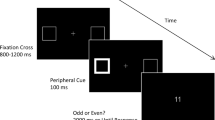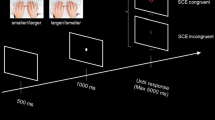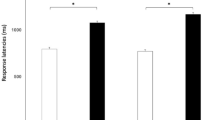Abstract
Spatial–numerical associations (small numbers—left/lower space and large numbers—right/upper space) are regularly found in simple number categorization tasks. These associations were taken as evidence for a spatially oriented mental number line. However, the role of spatial–numerical associations during more complex number processing, such as counting or mental arithmetic is less clear. Here, we investigated whether counting is associated with a movement along the mental number line. Participants counted aloud upward or downward in steps of 3 for 45 s while looking at a blank screen. Gaze position during upward counting shifted rightward and upward, while the pattern for downward counting was less clear. Our results, therefore, confirm the hypothesis of a movement along the mental number line for addition. We conclude that space is not only used to represent number magnitudes but also to actively operate on numbers in more complex tasks such as counting, and that the eyes reflect this spatial mental operation.


Similar content being viewed by others
Notes
The algorithm checks the dispersion of consecutive data points in a moving window by summing the differences between the points’ maximum and minimum x and y values ([max(x) – min(x)] + [max(y) – min(y)]). If the sum is below 100 pixels, the window represents a fixation and expands until the sum exceeds 100 pixels. The final window is registered as fixation with a duration corresponding to the interval between the timestamps of the first and last included sample. The centroid of the included points determines the x and y coordinate of the fixation.
Seven participants indeed performed their last few downward counting steps in the negative range (on average 4.2 counting steps, which cover approximately 15 % of their counting time). Counting downward in the negative range is similar to counting upwards and might potentially influence the hypothesized mental movement. However, visual inspection of the last part of the gaze path during downward counting for these seven participants showed no systematically different pattern when compared to the terminal gaze path of the other participants, and these cases were not treated differently. From the 11 participants who did not reach the negative range, only two had the number “2” as final counting result (which is the last number before reaching the negative range). These two participants reached “2” at the end of their counting time, as noted by the experimenter, suggesting that no participant stopped counting when reaching zero.
For sum-coded predictors (addition = 1, subtraction = −1), two times the estimate (104 pixels) reflect the mean difference between upward and downward counting. Note that this value is slightly different from the value we reported above (111 pixels); this difference is mainly driven by the different averaging procedure (over 1-s time points).
To validate the use of pupil size as indicator of cognitive effort, we first conducted another linear mixed model analysis with pupil size as fixed effect and participant as random intercept on response times, separately for addition and subtraction trials. Consistent with previous work (e.g., Kahneman et al., 1969; Nakayama et al., 2002), pupil size was a significant predictor of response times for both addition and subtraction trials (both ps < .001); response time increased with increasing pupil size, confirming that pupil size reliably reflects task difficulty.
References
Alibali, M. W., & DiRusso, A. A. (1999). The function of gesture in learning to count: more than keeping track. Cognitive Development, 14(1), 37–56.
Altmann, G. T. (2004). Language-mediated eye movements in the absence of a visual world: the ‘blank screen paradigm’. Cognition, 93(2), B79–B87. doi:10.1016/j.cognition.2004.02.005.
Andin, J., Fransson, P., Rönnberg, J., & Rudner, M. (2015). Phonology and arithmetic in the language–calculation network. Brain and Language, 143, 97–105.
Anelli, F., Lugli, L., Baroni, G., Borghi, A. M., & Nicoletti, R. (2014). Walking boosts your performance in making additions and subtractions. Frontiers in Psychology, 5, 1459.
Ashcraft, M. H. (1992). Cognitive arithmetic: a review of data and theory. Cognition, 44(1–2), 75–106.
Ashcraft, M. H., & Battaglia, J. (1978). Cognitive arithmetic: evidence for retrieval and decision processes in mental addition. Journal of Experimental Psychology Human Learning and Memory, 4(5), 527.
Barrouillet, P., & Lépine, R. (2005). Working memory and children’s use of retrieval to solve addition problems. Journal of Experimental Child Psychology, 91(3), 183–204.
Barsalou, L. W. (2008). Grounded cognition. Annual Review of Psychology, 59, 617–645. doi:10.1146/annurev.psych.59.103006.093639.
Bates, D., Maechler, M., Bolker, B., & Walker, S. (2015). lme4: linear mixed-effects models using Eigen and S4. R package version 1.1-8.
Binda, P., & Murray, S. O. (2015). Keeping a large-pupilled eye on high-level visual processing. Trends Cognitive Science, 19(1), 1–3. doi:10.1016/j.tics.2014.11.002.
Brandt, S. A., & Stark, L. W. (1997). Spontaneous eye movements during visual imagery reflect the content of the visual scene. Journal of Cognitive Neuroscience, 9(1), 27–38. doi:10.1162/jocn.1997.9.1.27.
Butterworth, B., Zorzi, M., Girelli, L., & Jonckheere, A. R. (2001). Storage and retrieval of addition facts: the role of number comparison. The Quarterly Journal of Experimental Psychology Section A, 54(4), 1005–1029. doi:10.1080/713756007.
Campbell, J. I. D. (1994). Architectures for numerical cognition. Cognition, 53(1), 1–44. doi:10.1016/0010-0277(94)90075-2.
Campbell, J. I. D. (2005). Handbook of mathematical cognition. New York: Psychology Press.
Carlson, R. A., Ayraamides, M. N., Cary, M., & Strasberg, S. (2007). What do the hands externalize in simple arithmetic. Journal of Experimental Psychology Learning Memory and Cognition, 33, 747–756.
Casasanto, D., & Boroditsky, L. (2008). Time in the mind: using space to think about time. Cognition, 106(2), 579–593. doi:10.1016/j.cognition.2007.03.004.
Cassia, V. M., McCrink, K., de Hevia, M. D., Gariboldi, V., & Bulf, H. (under review). Operational momentum and size ordering in preverbal infants. Psychological Research.
Corbetta, M., Akbudak, E., Conturo, T. E., Snyder, A. Z., Ollinger, J. M., Drury, H. A., et al. (1998). A common network of functional areas for attention and eye movements. Neuron, 21(4), 761–773.
Dehaene, S., Bossini, S., & Giraux, P. (1993). The mental representation of parity and number magnitude. Journal of Experimental Psychology General, 122(3), 371–396.
Ehrlichman, H., & Micic, D. (2012). Why do people move their eyes when they think? Current Directions in Psychological Science, 21(2), 96–100. doi:10.1177/0963721412436810.
Fias, W., & Fischer, M. H. (2005). Spatial representation of numbers. In J. I. D. Campbell (Ed.), Handbook of mathematical cognition (pp. 43–54). New York: Psychology Press.
Fischer, M. H. (2008). Finger counting habits modulate spatial-numerical associations. Cortex, 44(4), 386–392.
Fischer, M. H. (2012). A hierarchical view of grounded, embodied, and situated numerical cognition. Cognitive Processing, 13(1), 161–164.
Fischer, M. H., & Brugger, P. (2011). When digits help digits: spatial–numerical associations point to finger counting as prime example of embodied cognition. Frontiers in Psychology, 2.
Fischer, M. H., & Rottmann, J. (2005). Do negative numbers have a place on the mental number line. Psychology Science, 47(1), 22–32.
Fischer, M. H., & Shaki, S. (2014a). Spatial associations in numerical cognition-from single digits to arithmetic. The Quarterly Journal of Experimental Psychology, 67(8), 1461–1483. doi:10.1080/17470218.2014.927515.
Fischer, M. H., & Shaki, S. (2014b). Spatial biases in mental arithmetic. The Quarterly Journal of Experimental Psychology, 67(8), 1457–1460. doi:10.1080/17470218.2014.927516.
Fischer, M. H., & Shaki, S. (2015). Measuring spatial-numerical associations: evidence for a purely conceptual link. Psychol Res. doi:10.1007/s00426-015-0646-0
Freyd, J. J., & Finke, R. A. (1984). Representational momentum. Journal of Experimental Psychology Learning Memory and Cognition, 10(1), 126.
Ganor-Stern, D., Pinhas, M., Kallai, A., & Tzelgov, J. (2010). Holistic representation of negative numbers is formed when needed for the task. The Quarterly Journal of Experimental Psychology, 63(10), 1969–1981.
Gao, X., Yan, H., & Sun, H. (2015). Modulation of microsaccade rate by task difficulty revealed through between- and within-trial comparisons. Journal of Vision, 15(3), 1–15.
Gevers, W., Santens, S., Dhooge, E., Chen, Q., Bossche, L., Fias, W., et al. (2010). Verbal-spatial and visuospatial coding of number-space interactions. Journal of Experimental Psychology General, 139, 180–190.
Göbel, S. M., Shaki, S., & Fischer, M. H. (2011). The cultural number line: a review of cultural and linguistic influences on the development of number processing. Journal of Cross Cultural Psychology, 42(4), 543–565.
Grade, S., Lefèvre, N., & Pesenti, M. (2012). Influence of gaze observation on random number generation. Experimental Psychology, 60, 122–130.
Grant, E. R., & Spivey, M. J. (2003). Eye movements and problem solving: guiding attention guides thought. Psychological Science, 14(5), 462–466.
Groen, G. J., & Parkman, J. M. (1972). A chronometric analysis of simple addition. Psychological Review, 79(4), 329.
Gross, J., Hudson, C., & Price, D. (2009). The long term costs of numeracy difficulties. London: Every Child a Chance Trust and KPMG.
Hartmann, M. (2015). Numbers in the eye of the beholder: what do eye movements reveal about numerical cognition? Cognitive Processing, 16(1), 245–248. doi:10.1007/s10339-015-0716-7.
Hartmann, M., Farkas, R., & Mast, F. W. (2012a). Self-motion perception influences number processing: evidence from a parity task. Cognitive Processing, 13(1), 189–192. doi:10.1007/s10339-012-0484-6.
Hartmann, M., & Fischer, M. H. (2014). Pupillometry: the eyes shed fresh light on the mind. Current Biology, 24(7), R281–R282. doi:10.1016/j.cub.2014.02.028.
Hartmann, M., Gashaj, V., Stahnke, A., & Mast, F. (2014a). There is more than “more is up”: hand and foot responses reverse the vertical association of number magnitudes. Journal of Experimental Psychology Human Perception and Performance, 40(4), 1401–1414. doi:10.1037/a0036686.
Hartmann, M., Grabherr, L., & Mast, F. W. (2012b). Moving along the mental number line: interactions between whole-body motion and numerical cognition. Journal of Experimental Psychology Human Perception and Performance, 38(6), 1416–1427. doi:10.1037/a0026706.
Hartmann, M., Martarelli, C., Mast, F. W. (2014b). Eye movements during mental time travel follow a diagonal line. Conscious Cogn, 30, 201–209.
Hartmann, M., Mast, F. W., & Fischer, M. H. (2015). Spatial biases during mental arithmetic: evidence from eye movements on a blank screen. Frontiers in Psychology, 6, 12. doi:10.3389/fpsyg.2015.00012.
Holmes, K. J., & Lourenco, S. F. (2012). Orienting numbers in mental space: horizontal organization trumps vertical. The Quarterly Journal of Experimental Psychology, 65(6), 1044–1051. doi:10.1080/17470218.2012.685079.
Hubbard, T. L. (2014). Forms of momentum across space: representational, operational, and attentional. Psychonomic Bulletin Review, 21(6), 1371–1403.
Hubbard, E. M., Piazza, M., Pinel, P., & Dehaene, S. (2005). Interactions between number and space in parietal cortex. Nature Review Neuroscience, 6(6), 435–448.
Huette, S., Winter, B., Matlock, T., Ardell, D. H., & Spivey, M. (2014). Eye movements during listening reveal spontaneous grammatical processing. Frontiers in Psychology, 5, 410. doi:10.3389/fpsyg.2014.00410.
Ito, Y., & Hatta, T. (2004). Spatial structure of quantitative representation of numbers: evidence from the SNARC effect. Memory Cognition, 32(4), 662–673.
Johansson, R., Holsanova, J., & Holmqvist, K. (2006). Pictures and spoken descriptions elicit similar eye movements during mental imagery, both in light and in complete darkness. Cognitive Science, 30(6), 1053–1079. doi:10.1207/s15516709cog0000_86.
Johansson, R., & Johansson, M. (2014). Look here, eye movements play a functional role in memory retrieval. Psychological Science, 25(1), 236–242. doi:10.1177/0956797613498260.
Kahneman, D., & Beatty, J. (1966). Pupil diameter and load on memory. Science, 154, 3.
Kahneman, D., Tursky, B., Shapiro, D., & Crider, A. (1969). Pupillary, heart rate, and skin resistance changes during a mental task. Journal of Experimental Psychology, 79, 164–167.
Kennedy, A. (1983). On looking into space. In K. Rayner (Ed.), Eye movements in reading: perceptual and language processes (pp. 237–251). New York: Academic Press.
Kinsbourne, M. (1972). Eye and head turning indicates cerebral lateralization. Science, 176(4034), 539–541.
Knops, A., Dehaene, S., Berteletti, I., & Zorzi, M. (2014). Can approximate mental calculation account for operational momentum in addition and subtraction? The Quarterly Journal of Experimental Psychology (Hove), 67(8), 1541–1556. doi:10.1080/17470218.2014.890234.
Knops, A., Viarouge, A., & Dehaene, S. (2009). Dynamic representations underlying symbolic and nonsymbolic calculation: evidence from the operational momentum effect. Attention Perception Psychophysics, 71(4), 803–821. doi:10.3758/APP.71.4.803.
Knops, A., Zitzmann, S., & McCrink, K. (2013). Examining the presence and determinants of operational momentum in childhood. Frontiers in Psychology, 4, 325. doi:10.3389/fpsyg.2013.00325.
Lakoff, G., & Johnson, M. (1980). Conceptual metaphor in everyday language. The Journal of Philosophy, 77(8), 453–486.
Lavie, N. (2005). Distracted and confused? Selective attention under load. Trends in Cognitive Science, 9(2), 75–82. doi:10.1016/j.tics.2004.12.004.
Lepsien, J., Griffin, I. C., Devlin, J. T., & Nobre, A. C. (2005). Directing spatial attention in mental representations: interactions between attentional orienting and working-memory load. Neuroimage, 26(3), 733–743. doi:10.1016/j.neuroimage.2005.02.026.
Loetscher, T., Bockisch, C. J., Nicholls, M. E., & Brugger, P. (2010). Eye position predicts what number you have in mind. Current Biology, 20(6), R264–R265. doi:10.1016/j.cub.2010.01.015.
Lugli, L., Baroni, G., Anelli, F., Borghi, A. M., & Nicoletti, R. (2013). Counting is easier while experiencing a congruent motion. PLoS One, 8(5), e64500.
Marghetis, T., Nunez, R., & Bergen, B. K. (2014). Doing arithmetic by hand: hand movements during exact arithmetic reveal systematic, dynamic spatial processing. The Quarterly Journal of Experimental Psychology (Hove), 67(8), 1579–1596. doi:10.1080/17470218.2014.897359.
Martarelli, C. S., & Mast, F. W. (2011). Preschool children’s eye-movements during pictorial recall. British Journal of Developmental Psychology, 29(Pt 3), 425–436. doi:10.1348/026151010X495844.
Masson, N., & Pesenti, M. (2014). Attentional bias induced by solving simple and complex addition and subtraction problems. The Quarterly Journal of Experimental Psychology (Hove), 67(8), 1514–1526. doi:10.1080/17470218.2014.903985.
McCrink, K., Dehaene, S., & Dehaene-Lambertz, G. (2007). Moving along the number line: operational momentum in nonsymbolic arithmetic. Perception and Psychophysics, 69(8), 1324–1333.
Mock, J., Huber, S., Klein, E., Moeller, K. (under review). Insights into numerical cognition—considering eye-fixations in number processing and arithmetic. Psychological Research.
Myachykov, A., Cangelosi, A., Ellis, R., & Fischer, M. H. (2015a). The ocular resonance effect in spatial-numerical mapping. Acta Psychologica, 161, 162–169.
Myachykov, A., Ellis, R., Changeolosi, A., & Fischer, M. H. (under review). Ocular drift along the mental number line. Psychological Research.
Nakayama, M., Takahashi, K., & Shimizu, Y. (2002). The act of task difficulty and eye-movement frequency for the ‘Oculo-motor indices’. In Proceedings of the 2002 symposium on Eye tracking research and applications (pp. 37–42): ACM
Parsons, S., & Bynner, J. (2005). Does numeracy matter more?. London: National Research and Development Centre for Adult Literacy and Numeracy.
Pinhas, M., & Fischer, M. H. (2008). Mental movements without magnitude? A study of spatial biases in symbolic arithmetic. Cognition, 109(3), 408–415. doi:10.1016/j.cognition.2008.09.003.
Pinhas, M., Shaki, S., & Fischer, M. H. (2014). Heed the signs: operation signs have spatial associations. The Quarterly Journal of Experimental Psychology (Hove), 67(8), 1527–1540. doi:10.1080/17470218.2014.892516.
R Core Team. (2014). R: A language and environment for statistical computing. Vienna: R Foundation for Statistical Computing.
Ranzini, M., Lisi, M., Zorzi, M. (under review). Voluntary eye movements direct attention on the mental number space. Psychological Research.
Restle, F. (1970). Speed of adding and comparing numbers. Journal of Experimental Psychology, 83, 274.
Shaki, S., & Fischer, M. H. (2012). Multiple spatial mappings in numerical cognition. Journal of Experimental Psychology Human Perception and Performance, 38(3), 804.
Shaki, S., & Fischer, M. H. (2014). Random walks on the mental number line. Experimental Brain Research, 232, 43–49.
Shaki, S., Fischer, M. H., & Petrusic, W. M. (2009). Reading habits for both words and numbers contribute to the SNARC effect. Psychonomic Bulletin Review, 16(2), 328–331. doi:10.3758/PBR.16.2.328.
Sheliga, B. M., Riggio, L., & Rizzolatti, G. (1994). Orienting of attention and eye movements. Experimental Brain Research, 98(3), 507–522.
Siegenthaler, E., Costela, F. M., McCamy, M. B., Di Stasi, L. L., Otero-Millan, J., Sonderegger, A., et al. (2014). Task difficulty in mental arithmetic affects microsaccadic rates and magnitudes. European Journal of Neuroscience, 39, 287–294.
Singmann, H., & Bolker, M. (2014). afex: analysis of factorial experiments. R package version 0.12–135
Spivey, M. J., & Geng, J. J. (2001). Oculomotor mechanisms activated by imagery and memory: eye movements to absent objects. Psychological Research, 65(4), 235–241.
Stocker, K., Hartmann, M., Martarelli, C., & Mast, F. W. (2015). Eye movements reveal mental scanning through time. Cognitive Science, 1-23. doi:10.1111/cogs.12301
Tzelgov, J., Ganor-Stern, D., & Maymon-Schreiber, K. (2009). The representation of negative numbers: exploring the effects of mode of processing and notation. The Quarterly Journal of Experimental Psychology, 62(3), 605–624.
Van Gompel, R. P. G., Fischer, M. H., Murray, W., & Hill, R. L. (2007). Eye movements: a window on mind and brain. Oxford: Elsevier.
Varma, S., & Schwartz, D. L. (2011). The mental representation of integers: an abstract-to-concrete shift in the understanding of mathematical concepts. Cognition, 121, 363–385.
Walsh, V. (2003). A theory of magnitude: common cortical metrics of time, space and quantity. Trends Cognitive Science, 7(11), 483–488.
Walsh, V. (2014). A theory of magnitude: the parts that sum to numbers. In R. C. Kadosh & A. Dowker (Eds.), The Oxford handbook of numerical cognition. Oxford: Oxford Universtiy Press.
Wiemers, M., Bekkering, H., & Lindemann, O. (2014). Spatial interferences in mental arithmetic: evidence from the motion-arithmetic compatibility effect. The Quarterly Journal of Experimental Psychology, 67(8), 1557–1570. doi:10.1080/17470218.2014.889180.
Winter, B. (2013). Linear models and linear mixed effects models in R with linguistic applications. arXiv:1308.5499. http://arxiv.org/pdf/1308.5499.pdf
Winter, B., Marghetis, T., & Matlock, T. (2015a). Of magnitudes and metaphors: explaining cognitive interactions between space, time, and number. Cortex, 64, 209–224.
Winter, B., & Matlock, T. (2013). More is up … and right: random number generation along two axes. In M. Knauff, N. Pauen, N. Sebanz, & I. Wachsmuth (Eds.), Proceedings of the 35th Annual Conference of the Cognitive Science Society (pp. 3789–3794). Austin: Cognitive Science Society.
Winter, B., Matlock, T., Shaki, S., & Fischer, M. H. (2015b). Mental number space in three dimensions. Neuroscience and Biobehavioral Reviews, 57, 209–219.
Yu, X., Liu, J., Li, D., Cui, J., & Zhou, X. (under review). Dynamic mental number line in symple arithmetic. Psychological Research.
Zbrodoff, N. J., & Logan, G. D. (1990). On the relation between production and verification tasks in the psychology of simple arithmetic. Journal of Experimental Psychology Learning Memory and Cognition, 16(1), 83–97.
Acknowledgments
This research was funded by the Swiss National Science Foundation (P2BEP1_152104).
Author information
Authors and Affiliations
Corresponding author
Rights and permissions
About this article
Cite this article
Hartmann, M., Mast, F.W. & Fischer, M.H. Counting is a spatial process: evidence from eye movements. Psychological Research 80, 399–409 (2016). https://doi.org/10.1007/s00426-015-0722-5
Received:
Accepted:
Published:
Issue Date:
DOI: https://doi.org/10.1007/s00426-015-0722-5




